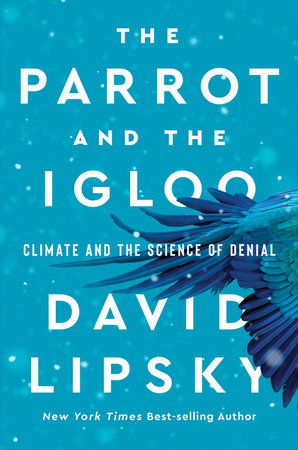The Parrot and the Igloo: Climate and the Science of Denial
- By David Lipsky
- W.W. Norton & Company
- 496 pp.
- Reviewed by Christopher Lancette
- July 24, 2023
An entertaining look at a maddening topic.

I’ve got to thank bestselling author David Lipsky for pulling off a nifty trick in his latest book — making me laugh while reading about the potential end of human life on this planet. Climate change isn’t typically a knee-slapper, but Lipsky had the prescience to slip in a series of guffaws that makes it much easier to keep turning the pages. It’s the kind of deft humor Larry Gelbart and Gene Reynolds used to keep viewers tuning into a show about meatball surgery and misery during the Korean War.
Of course, “M*A*S*H” wasn’t wholly a comedy, and neither is The Parrot and the Igloo. But it’s the breezy notes in both that make them bearable, that make them works you can learn from and be galvanized by instead of being left feeling suicidal and wanting to get drunk.
Recounting the tale of a Russian named Georg Richmann who, in 1754, attempted to do what Benjamin Franklin had done two years prior, Lipsky reports that the man died when lightning delivered him a different fate than it did his experimenting predecessor:
“Richmann became a casualty and a novelty: the first person electrocuted by love of science.”
The fatality probably isn’t funny to his descendants (if he has any), but the wittily told account early in The Parrot and the Igloo gives readers the confidence that we can get through this treatise on such a somber subject as climate change.
Lipsky also pokes fun at Samuel Morse, remembered today as the inventor of that obscure dashes-and-dots code most of us have only seen in movies. He reports that Morse was primarily a guy who succeeded at failing. Yet when he got the code thing right, he launched a communications revolution with the first-ever message sent via telegram: “What hath God wrought?”
It’s the kind of filled-with-dread query humans have asked after every major technological advance, even as a certain subset inevitably denies the science behind those advances. Part of the reason I latched onto Lipsky’s book is because I’m becoming a bit of a glutton for punishment in feeding my brain tales of existential environmental terror. “Climate science is a Hall of Ironies,” Lipsky writes. “Climate denial is the broken bottles and roasted tire smell of the parking lot. It’s the scientists never invited inside.”
Count me in!
But there’s so much more to this book than a focus on the hideous history of climate-change denialism and the vile people who still traffic in it today. The cabal that once tried to convince us cigarettes don’t cause cancer was fed by the same manure, and often the same people, that brought heresy to climate science. Lipsky calls them “denial corporations” full of bad-actor companies such as tobacco’s Philip Morris International, public relations’ Hill & Knowlton, and jilted researchers happy to trade conscience for cash. The way Lipsky connects all the dashes and dots makes it easier to understand why Hawkeye Pierce hit the bottle so hard.
But as fascinating as the destination of denialism is, the author’s stops along the way are equally enthralling. The first section of the book is dedicated to inventors we only thought we knew — including Franklin, Thomas Edison, and George Westinghouse. The second section heralds the scientists most of us have never heard of unless we have a bunch of letters after our names or are green junkies. People like Roger Revelle, an oceanographer and climate-study pioneer who, as early as the 1950s, posited that adding too much carbon dioxide to the atmosphere could lead to global warming. And figures like Jim Hansen, a NASA climate scientist nicknamed “the Paul Revere of Global Warming,” who testified to Congress in 1988 that the age of a hotter planet had arrived.
The third and final section is the Hall of Shame wing, the one with all the liars, cheats, demagogues, sellouts, and other sickening SOBs. It’s the part you have to brace yourself to read, filled with the likes of Dr. Frederick Seitz. When Big Tobacco stopped lining one of this stooge’s pockets, he opened another to Big Oil. The religious cult the Moonies even helped finance his performative science denialism. Then there’s S. Fred Singer, who Lipsky describes as “the most prominent denier, a rocket scientist who couldn’t secure a contract from NASA” who was always “spouting off, his mouth out of uniform.”
All these bad actors, Lipsky summarizes, were “specialists who established an immaculate and collaborative network of untruth…mostly for money.”
He ends with another reminder that real scientists warned us about climate change a long time ago. Editorial boards screamed at us to take action as far back as the 1960s. A Washington Post climate-change editorial from 1965 may as well have been written yesterday:
“Mankind’s ability to protect itself is less likely to be limited by inadequate knowledge, than by its notorious inability to turn knowledge into effective public action.”
Not even an author as gifted as David Lipsky can provide a laugh track for that one.
Christopher Lancette is a Maryland-based writer, essayist, and multimedia storyteller focusing on nature and the environment. He publishes a passion project at EyeOnSligoCreek.com. Follow him on Twitter at @chrislancette.

